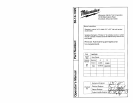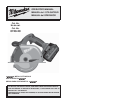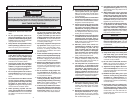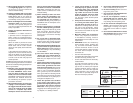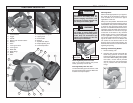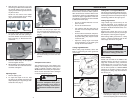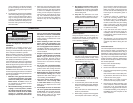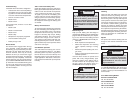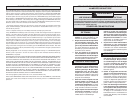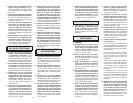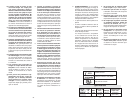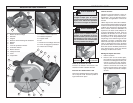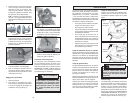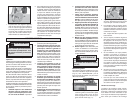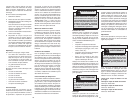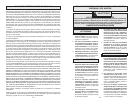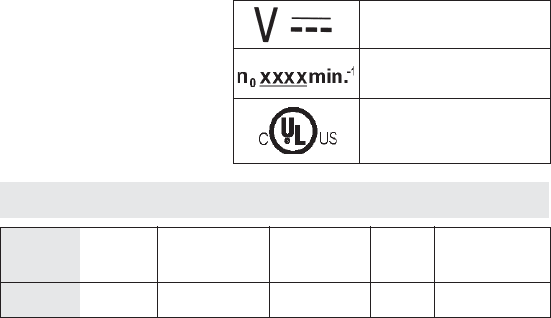
4 5
work or pull the saw backward while
the blade is in motion or KICKBACK
may occur. Investigate and take cor-
rective actions to eliminate the cause
of blade binding.
c) When restarting a saw in the work-
piece, center the saw blade in the
kerf and check that saw teeth are
not engaged into the material. If
saw blade is binding, it may walk up or
KICKBACK from the workpiece as the
saw is restarted.
d) Support large panels to minimize
the risk of blade pinching and KICK-
BACK. Large panels tend to sag under
their own weight. Supports must be
placed under the panel on both sides,
near the line of cut and near the edge
of the panel.
e) Do not use dull or damaged blade.
Unsharpened or improperly set blades
produce narrow kerf causing excessive
friction, blade binding and KICKBACK.
f) Blade depth and bevel adjusting lock-
ing levers must be tight and secure
before making cut. If blade adjustment
shifts while cutting, it may cause binding
and KICKBACK.
g) Use extra caution when making a
"Plunge Cut" into existing walls or
other blind areas. The protruding
blade may cut objects that can cause
KICKBACK.
3. Check lower guard for proper closing
before each use. Do not operate the
saw if lower guard does not move
freely and close instantly. Never clamp
or tie the lower guard into the open po-
sition. If saw is accidentally dropped,
lower guard may be bent. Raise the
lower guard with the retracting handle
and make sure it moves freely and does
not touch the blade or any other part, in
all angles and depths of cut.
4. Check the operation and condition
of the lower guard spring. If the
guard and the spring are not operat-
ing properly, they must be serviced
before use. Lower guard may operate
sluggishly due to damaged parts, gum-
my deposits, or a buildup of debris.
f) When ripping always use a rip fence
or straight edge guide. This improves
the accuracy of cut and reduces the
chance of blade binding.
g) Always use blades with correct size
and shape (diamond vs. round) arbor
holes. Blades that do not match the
mounting hardware of the saw will run
eccentrically, causing loss of control.
h) Never use damaged or incorrect blade
washers or bolts. The blade washers
and bolts were specially designed for
your saw, for optimum performance and
safety of operation.
2. Causes and Operator Prevention of
KICKBACK:
KICKBACK is a sudden reaction to
a pinched, bound or misaligned saw
blade, causing an uncontrolled saw to
lift up and out of the workpiece toward
the operator.
When the blade is pinched or bound
tightly by the kerf closing down, the
blade stalls and the motor reaction
drives the unit rapidly back toward the
operator.
If the blade becomes twisted or mis-
aligned in the cut, the teeth at the back
edge of the blade can dig into the top
surface of the wood causing the blade
to climb out of the kerf and jump back
toward operator.
KICKBACK is the result of saw misuse and/or
incorrect operating procedures or conditions
and can be avoided by taking proper precau-
tions as given below:
a) Maintain a fi rm grip with both hands
on the saw and position your arms
to resist KICKBACK forces. Posi-
tion your body to either side of the
blade, but not in line with the blade.
KICKBACK could cause the saw to jump
backwards, but kickback forces can
be controlled by the operator, if proper
precautions are taken.
b) When blade is binding, or when inter-
rupting a cut for any reason, release
the trigger and hold the saw motion-
less in the material until the blade
comes to a complete stop. Never
attempt to remove the saw from the
5. Lower guard should be retracted
manually only for special cuts such
as "Plunge Cuts" and "Compound
Cuts". Raise lower guard by retract-
ing handle and as soon as blade
enters the material, the lower guard
must be released. For all other saw-
ing, the lower guard should operate
automatically.
6. Always observe that the lower guard
is covering the blade before plac-
ing saw down on bench or fl oor. An
unprotected, coasting blade will cause
the saw to walk backwards, cutting
whatever is in its path. Be aware of the
time it takes for the blade to stop after
switch is released.
7. Maintain labels and nameplates.
These carry important information.
If unreadable or missing, contact a
MILWAUKEE service facility for a free
replacement.
8. WARNING! Some dust created by
power sanding, sawing, grinding, drill-
ing, and other construction activities
contains chemicals known to cause
cancer, birth defects or other reproduc-
tive harm. Some examples of these
chemicals are:
• lead from lead-based paint
• crystalline silica from bricks and cement
and other masonry products, and
• arsenic and chromium from chemically-
treated lumber.
Your risk from these exposures varies,
depending on how often you do this
type of work. To reduce your exposure
to these chemicals: work in a well ven-
tilated area, and work with approved
safety equipment, such as those dust
masks that are specially designed to
fi lter out microscopic particles.
9. Do not touch material after it has been
cut. Cut material may be very hot.
10. Do not use cutting oil. The use of cut-
ting oil may cause a fi re.
11. Do not use tool near fl ammable mate-
rial. Sparks may cause fi re.
12. Do not cut workpieces covered or
stained with gas, oil, solvents, thin-
ners, etc. Exposure to these materials
may damage the transparent guard.
13. Do not remove the transparent front
guard. If the transparent front guard
is damaged or missing, return tool to
authorized service station for replace-
ment.
14. Do not start the blade when in contact
with workpiece. Wait for blade to reach
full speed before beginning cut.
Symbology
Volts Direct Current
No Load Revolutions
per Minute (RPM)
Underwriters Laboratories,
Inc., United States and
Canada
Blade
Size
6-7/8"
Cat.
No.
0740-20
Volts
DC
28
Specifi cations
No Load
RPM
3 200
Arbor
20 mm
Depth of Cut
At 90°
0 to 2-3/8"



